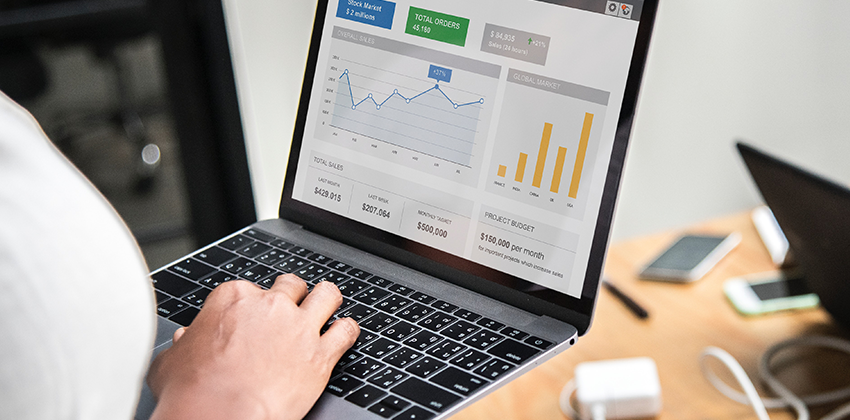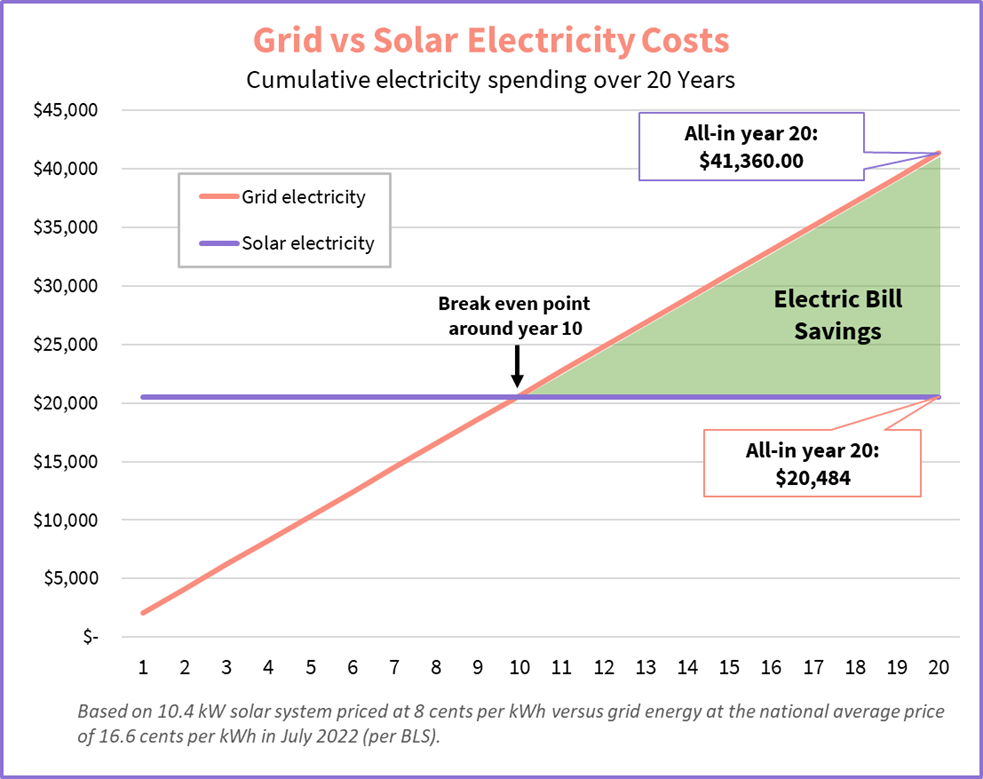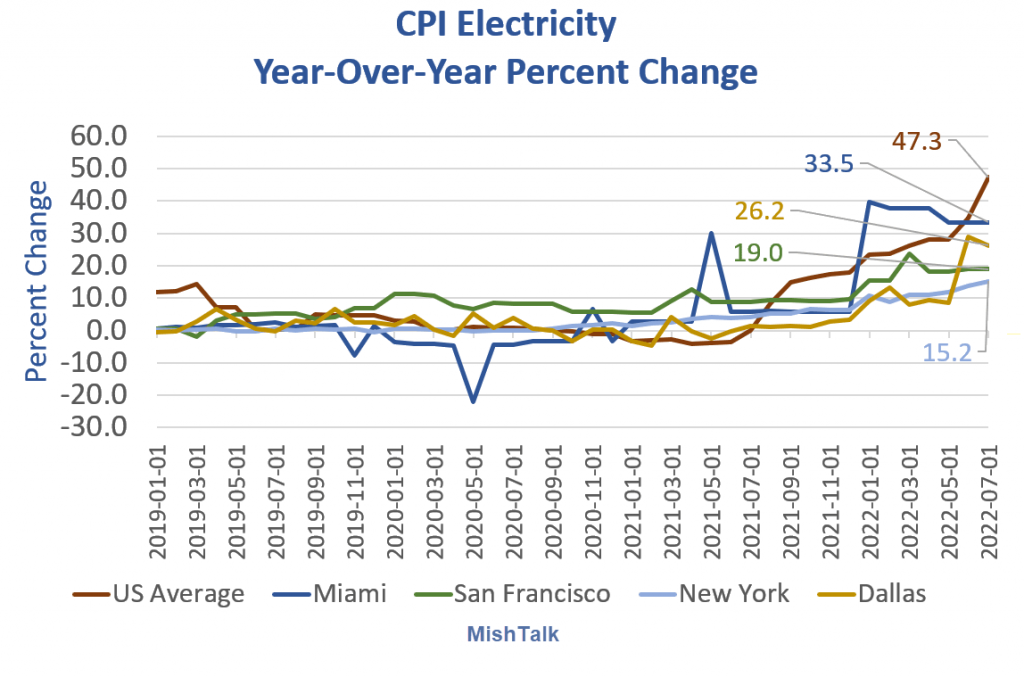How Do Solar Panels Lower Your Electric Bill?

We need electricity for everything from air conditioning and kitchen appliances to TVs and cell phones, and all of that usage adds up. But did you know you can use solar panels to lower your electric bill?
By fixing your electricity costs at a low rate, solar systems are often the best way of reducing your electric bill without making drastic cuts to your energy usage.
In this article, we’ll explore how to use solar panels to lower your utility bill and give you the tools to start saving.
Ready to go solar? Get multiple quotes here.
How to Lower Your Electric Bill With Solar Panels
To begin, let’s identify the three primary problems with electric bills:
- They’re expensive
- They’re continually getting more expensive
- They’re unpredictable
We’ll go over each problem, and show how solar is a solution to fix it and lower your electric bill.
Electric Bills Are Expensive
It may not feel like it, but your probably paying way more for grid energy than you would be for solar.
The price of electricity is measured in cents per kilowatt-hour (kWh). According to the US Bureau of Labor Statistics, the national average price for electricity in July 2022 was $0.166 per kWh.
Seattle had the lowest price of any major metro area at $0.118 per kWh while San Diego, Houston, Urban Hawaii, and San Francisco all had electricity rates above $0.311 per kWh.
Factoring in discounts and the 30% federal solar tax credit, the average price of solar purchased through solar.com is between $0.06 and $0.08 per kWh.
That’s less than half of the national average and nearly four times less than the price of grid electricity in San Francisco. It’s even lower than the price in Seattle, where electricity is dirt cheap!
Let’s see how the price of grid power in major US metros compares to the price for solar through solar.com. (We’ll even use the higher-end of the solar.com range to be conservative.)
Related reading: Pros and Cons of Going Solar
Price of grid vs solar electricity in major US metros
| GRID POWER PRICE ($/KWH)* | AVERAGE SOLAR.COM PRICE ($/KWH) | MARKUP FOR GRID ELECTRICITY | |
| National average | 0.166 | 0.08 | 107.5% |
| Seattle | 0.118 | 0.08 | 47.5% |
| Houston | 0.345 | 0.08 | 331.25% |
| Los Angeles | 0.244 | 0.08 | 205% |
| Boston | 0.270 | 0.08 | 237.5% |
| Chicago | 0.185 | 0.08 | 131.25% |
| Miami | 0.162 | 0.08 | 102.5% |
| Denver | 0.152 | 0.08 | 90% |
Do solar panels lower your electric bill?
Solar panels can not only lower your electric bill — they can completely replace it.
Your electric bill depends primarily on two factors:
- How much electricity you use
- The rate at which the utility company charges for that electricity
If you’re stuck on grid power, there’s almost nothing you can do to lower your rate. So your left with trying to lower your usage by putting a lock on the thermostat and using a binoculars to watch Netflix through your neighbor’s window.
But by using solar panels, you can lower your electric bill by slashing the rate to around 8 cents per kWh — far lower than the price per kWh in any major US metro.
Think of going solar as replacing your electricity bill with monthly payments for your solar equipment. Here’s how that looks over 20 years of paying 8 cents/kWh for a cash solar purchase versus the national average 16.6 cents/kWh for grid energy.
Home solar versus grid electricity

In this scenario, the grid user paid $41,360 for 20 years of electricity, while the solar owner paid $20,484 for 20 years of electricity.
All-in, using solar panels lowered the cumulative electricity bill by $20,876 over 20 years. And the overall savings could be more than that for three reasons:
- Most solar equipment is warrantied for 25 years and lasts much longer than that
- Solar panels increase your home value
- Grid electricity rates increase over time
Use our solar savings calculator to see how much you can save.
Grid Electricity Rates Are Always Rising
Grid electricity rates are already higher than solar, and they will continue to increase over time. By taking these rate hikes into account, solar panels can lower your electric bill even further.
In the last 20 years, the price of grid energy has increased 2.79% per year on average, according to the U.S. Energy Information Administration (EIA). And the EIA is projecting a 2.54% increase from 2022 to 2023.
That would bring the national average from 16.6 cents per kWh to 17.0 cents per kWh.
Meanwhile, going solar fixes your electricity costs for the lifetime of the system. So if go solar in 2023 at 8 cents per kWh, you’ll still essentially be paying 8 cents per kWh in 2043 when grid energy is over cents per kWh (based on 2.79% increase per year — it could be more!).
Here’s how paying for solar versus grid electricity looks over 20 years when accounting for 2.79% rate hikes based on the historical average and 5% rate hikes that are more in line the average rate of inflation.
Home solar versus grid electricity with rate hikes

Taking rate hikes into consideration, solar owners would save:
- $33,912.50 over 20 years of 2.79% annual rate hikes
- $47896.39 over 20 years of 5% annual rate hikes
How much will the price of grid electricity go up over the next 20 years? Nobody knows, but it’s clear that solar is the cheaper bet over the long haul.
Why do utilities hike electricity rates?
Even as utilities add cleaner, cheaper renewable energy into the electric grid, they face enormous costs to maintain and expand the grid.
Since the US was one of the first countries to build out an electric grid, it also means that our system is one of the oldest. Utility companies spend hundreds of millions of dollars every year upgrading their towers, lines, substations, and transformers. These costs continue to drive up the cost of delivering electricity, even as cheaper generation sources come online.
Homeowners can lower electric bills with a solar power system. Solar systems have almost no ongoing fuel or maintenance costs – sunshine is free! Solar systems also produce power right where it’s needed (in the home), which avoids costly transmission infrastructure.
As grid maintenance costs continue to rise, solar systems will provide increasingly attractive returns.
Electric Bills Are Unpredictable
In the last section we used nice, steady rate hikes to show how grid electricity increases over time. But in reality, grid electricity rates are anything but steady.
Take a look at this graph of year-over-year electricity price changes since 2019 from MishTalk.

See a pattern? We don’t either. It’s madness.
But here’s the takeaway: The average American paid 47.3% more for grid electricity in July 2022 than they did in July 2021.
Few people, if any, saw that coming.
Skip the guessing game with solar
With solar, energy costs are extremely predictable.
Many homeowners are able to cover 100% of their energy needs with their solar system, in which case they will typically only have a $10-20 minimum service charge from the utility that goes towards grid maintenance fees, charges for net metering, and other associated costs.
If the solar system doesn’t cover 100% of their needs, then they will have some level of remaining electric bill that will vary through the year.
With a cash purchase, there’s no recurring cost for the system or power. With financing, there’s a set monthly payment that doesn’t vary based on season or immediate usage. Either way, this stability can be very valuable for homeowners budgeting their monthly expenses.

Lower your electric bill with solar panels
To recap, solar panels do two things to reduce your electric bill:
- They set the price you pay for electricity lower than what you would pay on the grid (~8 cents per kWh for solar versus the national average 16.6 cents per kWh for grid)
- They shield you from the ever-rising cost of grid electricity (which is projected to rise more than 6% in the next year)
In addition, solar panels also increase your home value, reduce your carbon emissions, and bring stability to your electricity costs.